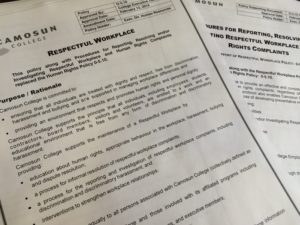The provincial Sexual Violence and Misconduct Policy Act, which was tabled late April, will ensure that postsecondary institutions in BC create and maintain policies to prevent and respond to sexual misconduct on campuses. After receiving royal assent, there is expected to be a grace period of one year before the bill takes effect, allowing institutions the time to develop appropriate policies.
According to Camosun College Student Society (CCSS) External Executive Rachael Grant, students currently in attendance at Camosun College would benefit greatly from the creation of this act, as the college does not currently have policy specifically relating to sexual assault.
“The issue is that there is actually no articulated policy at this point, and that’s actually the case for most postsecondary institutions,” says Grant. “There is no articulated structure that a survivor of sexual assault can navigate to report their assault. That is something that is being addressed on a bigger level right now in BC, and it is a really important conversation.”

Even though Camosun’s Respectful Workplace policy covers harassment—including sexual harassment—and assault, Camosun Vice President of Student Experience Joan Yates says that she feels that Camosun’s policy is lacking.
“We are really mindful that we have got to look at our student conduct policy and now add a component to it that is highly specific on this issue, and we don’t have that currently,” says Yates. “It is a gap and we know that. We want to be very mindful of the victim’s circumstances and be intensely sensitive to this.”
Currently, according to Yates, if students have been subject to an assault or any disturbance on campus, they have many options open to them for reporting an incident. They are instructed to contact Camosun Manager of Campus Security Byron Loucks, the counselling department, or student services.
“Our number of mechanisms for it is not to confuse or flummox students, but more so that there are a lot of points that can pull the student in,” says Yates. “For example, our counselling department is geared for this, our safety department is geared for this, our student services department is geared for this, so if a student went anywhere in this organization, in those areas, we should have a process that kicks into place for them.”
Grant says that having a male Manager of Campus Security as the contact point for people reporting sexual harassment is problematic, as is the amount of security on Camosun campuses.
“Personally, as a woman on campus, I wouldn’t feel comfortable reporting to that individual, but I would also add that the amount of security that is present on campus is incredibly lacking, so that is a very minimal layer of support when you are trying to, ideally, protect students,” says Grant. “That isn’t enough, by any means, if that is being suggested as the primary focus of contact for a survivor of an assault to access.”
Loucks is one of the people in charge of keeping Camosun safe; he is also co-chair of the Safety Net committee, which is the deciding body on the best course of action for issues that arise on campus.
“There needs to be one centralized place that people can contact or call, and when people contact or call us, then it’s my responsibility to engage the right people to ensure that that situation is dealt with,” says Loucks. “That could be bringing the two parties together, it could be bringing in program directors and leads, it could be as much as taking it to the Safety Net group and having a meeting with Safety Net. So, really, more than anything else, I think it is just so there is one centralized contact.”
Grant says she was unaware of the existence of Safety Net; there is little documentation available to students on who they are and what they do. Promoting College Safety: A Resource Guide for Employees is a document available through Camosun’s intranet; 200 were printed and it can not be accessed through the college website’s search engine.
Camosun College Ombudsman Carter MacDonald is a member of the Safety Net committee; he helped develop the resource guide in question.
“We don’t refer to sexual assault very specifically, but it is something that was developed by the committee,” MacDonald says of the resource guide. “It talks about dealing with problems and disruptive behaviours. It talks about the Safety Net group, the composition of it, and the resources that are available.”
Policies and procedures around this issue are going to be changing very soon, not just for Camosun but for all other institutions in BC. For now, Camosun is waiting to see what happens next.
“The reality is all postsecondary education institutions are waiting now for the provincial government’s sexual-assault policy work to be fully released, and it hasn’t yet,” says Camosun Vice President of Education John Boraas. “I have done my best to step speed on what they are contemplating, but we don’t have the document yet.”
